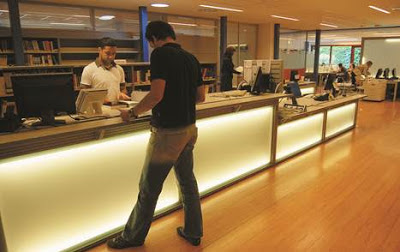SAIS Bologna's library has one of Europe's largest English-language collections in the field of international relations.
What exactly is available to students and outside users, and how can they learn to use the vast material?
I spoke with Ludovica Barozzi, the library's public services coordinator, one year after a post featuring head librarian Gail Martin.
Q: What resources are available to students?
What exactly is available to students and outside users, and how can they learn to use the vast material?
I spoke with Ludovica Barozzi, the library's public services coordinator, one year after a post featuring head librarian Gail Martin.
 |
| Ludovica Barozzi |
Barozzi: Students have access to resources both on paper and in electronic format.
In terms of paper materials, we have around 85,000 books and periodicals on international relations, economics and history. We hold several copies of all required readings for courses which students can take out on short loan.
In terms of electronic materials, our resources include thousands of e-books and CIAO, which stands for Course Items Available Online. CIAO is an online repository where students can find documents for their classes: journal articles, reports and parts of books -- within the limits of copyright.
Students have access also to hundreds of online databases that provide journal articles, policies, statistics, papers and much more including maps, pictures and speeches.
Another tool used for some classes is Blackboard, which allows for interactive communication between professors and students.
In terms of paper materials, we have around 85,000 books and periodicals on international relations, economics and history. We hold several copies of all required readings for courses which students can take out on short loan.
In terms of electronic materials, our resources include thousands of e-books and CIAO, which stands for Course Items Available Online. CIAO is an online repository where students can find documents for their classes: journal articles, reports and parts of books -- within the limits of copyright.
Students have access also to hundreds of online databases that provide journal articles, policies, statistics, papers and much more including maps, pictures and speeches.
Another tool used for some classes is Blackboard, which allows for interactive communication between professors and students.
Q: How do you help students familiarize themselves with the library and its resources?
Barozzi: At the beginning of the year we hold library information sessions. During these sessions we give general information on how the library works and the services we provide. We also explain how the short loan reserve system works.
We offer one-hour training sessions on electronic resources. Here we combine some theory and practice. The theoretical part helps students understand the logic behind databases. Once you get the gist, you learn how to use most databases.
We hold around 10 sessions during the academic year, and upon request I've set up ad hoc training with interested students.
We also provide students individual help with using the different databases and finding materials for their papers including books, articles and specific data.
 |
| The Robert H. Evans Library |
We offer one-hour training sessions on electronic resources. Here we combine some theory and practice. The theoretical part helps students understand the logic behind databases. Once you get the gist, you learn how to use most databases.
We hold around 10 sessions during the academic year, and upon request I've set up ad hoc training with interested students.
We also provide students individual help with using the different databases and finding materials for their papers including books, articles and specific data.
Q: Why should students come to the training sessions?
Barozzi: All students have used a library before and most know how to use a database. However, with the training sessions they have the opportunity to become familiar with some specific SAIS tools that are of great help in optimizing the research process and saving time.

No comments:
Post a Comment